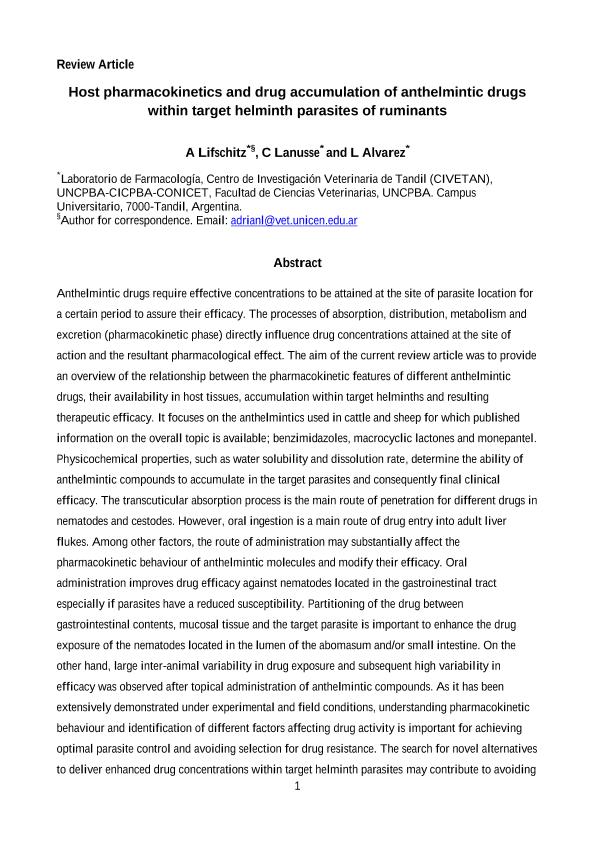Mostrar el registro sencillo del ítem
dc.contributor.author
Lifschitz, Adrian Luis

dc.contributor.author
Lanusse, Carlos Edmundo

dc.contributor.author
Alvarez, Luis Ignacio

dc.date.available
2018-09-06T16:05:45Z
dc.date.issued
2017-07
dc.identifier.citation
Lifschitz, Adrian Luis; Lanusse, Carlos Edmundo; Alvarez, Luis Ignacio; Host pharmacokinetics and drug accumulation of anthelmintics within target helminth parasites of ruminants; New Zealand Veterinary Assoc Inc; New Zealand Veterinary Journal; 65; 4; 7-2017; 176-184
dc.identifier.issn
0048-0169
dc.identifier.uri
http://hdl.handle.net/11336/58534
dc.description.abstract
Anthelmintic drugs require effective concentrations to be attained at the site of parasite location for a certain period to assure their efficacy. The processes of absorption, distribution, metabolism and excretion (pharmacokinetic phase) directly influence drug concentrations attained at the site of action and the resultant pharmacological effect. The aim of the current review article was to provide an overview of the relationship between the pharmacokinetic features of different anthelmintic drugs, their availability in host tissues, accumulation within target helminths and resulting therapeutic efficacy. It focuses on the anthelmintics used in cattle and sheep for which published information on the overall topic is available; benzimidazoles, macrocyclic lactones and monepantel. Physicochemical properties, such as water solubility and dissolution rate, determine the ability of anthelmintic compounds to accumulate in the target parasites and consequently final clinical efficacy. The transcuticular absorption process is the main route of penetration for different drugs in nematodes and cestodes. However, oral ingestion is a main route of drug entry into adult liver flukes. Among other factors, the route of administration may substantially affect the pharmacokinetic behaviour of anthelmintic molecules and modify their efficacy. Oral administration improves drug efficacy against nematodes located in the gastroinestinal tract especially if parasites have a reduced susceptibility. Partitioning of the drug between gastrointestinal contents, mucosal tissue and the target parasite is important to enhance the drug exposure of the nematodes located in the lumen of the abomasum and/or small intestine. On the other hand, large inter-animal variability in drug exposure and subsequent high variability in efficacy is observed after topical administration of anthelmintic compounds. As it has been extensively demonstrated under experimental and field conditions, understanding pharmacokinetic behaviour and identification of different factors affecting drug activity is important for achieving optimal parasite control and avoiding selection for drug resistance. The search for novel alternatives to deliver enhanced drug concentrations within target helminth parasites may contribute to avoiding misuse, and prolong the lifespan of existing and novel anthelmintic compounds in the veterinary pharmaceutical market.
dc.format
application/pdf
dc.language.iso
eng
dc.publisher
New Zealand Veterinary Assoc Inc

dc.rights
info:eu-repo/semantics/openAccess
dc.rights.uri
https://creativecommons.org/licenses/by-nc-sa/2.5/ar/
dc.subject
Anthelmintic Drugs
dc.subject
Drug Transfer
dc.subject
Parasite Exposure
dc.subject
Pharmacokinetics
dc.subject
Resistance
dc.subject
Ruminants
dc.subject.classification
Otras Ciencias Veterinarias

dc.subject.classification
Ciencias Veterinarias

dc.subject.classification
CIENCIAS AGRÍCOLAS

dc.title
Host pharmacokinetics and drug accumulation of anthelmintics within target helminth parasites of ruminants
dc.type
info:eu-repo/semantics/article
dc.type
info:ar-repo/semantics/artículo
dc.type
info:eu-repo/semantics/publishedVersion
dc.date.updated
2018-09-05T15:52:45Z
dc.journal.volume
65
dc.journal.number
4
dc.journal.pagination
176-184
dc.journal.pais
Nueva Zelanda

dc.description.fil
Fil: Lifschitz, Adrian Luis. Consejo Nacional de Investigaciones Científicas y Técnicas. Centro Científico Tecnológico Conicet - Tandil. Centro de Investigación Veterinaria de Tandil. Universidad Nacional del Centro de la Provincia de Buenos Aires. Centro de Investigación Veterinaria de Tandil. Provincia de Buenos Aires. Gobernación. Comision de Investigaciones Científicas. Centro de Investigación Veterinaria de Tandil; Argentina
dc.description.fil
Fil: Lanusse, Carlos Edmundo. Consejo Nacional de Investigaciones Científicas y Técnicas. Centro Científico Tecnológico Conicet - Tandil. Centro de Investigación Veterinaria de Tandil. Universidad Nacional del Centro de la Provincia de Buenos Aires. Centro de Investigación Veterinaria de Tandil. Provincia de Buenos Aires. Gobernación. Comision de Investigaciones Científicas. Centro de Investigación Veterinaria de Tandil; Argentina
dc.description.fil
Fil: Alvarez, Luis Ignacio. Consejo Nacional de Investigaciones Científicas y Técnicas. Centro Científico Tecnológico Conicet - Tandil. Centro de Investigación Veterinaria de Tandil. Universidad Nacional del Centro de la Provincia de Buenos Aires. Centro de Investigación Veterinaria de Tandil. Provincia de Buenos Aires. Gobernación. Comision de Investigaciones Científicas. Centro de Investigación Veterinaria de Tandil; Argentina
dc.journal.title
New Zealand Veterinary Journal

dc.relation.alternativeid
info:eu-repo/semantics/altIdentifier/doi/http://dx.doi.org/10.1080/00480169.2017.1317222
dc.relation.alternativeid
info:eu-repo/semantics/altIdentifier/url/https://www.tandfonline.com/doi/abs/10.1080/00480169.2017.1317222
Archivos asociados
